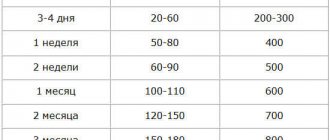How to develop your baby at 6 months? Six-month-old babies develop exponentially. Their physical form gives room for movement, conscious coordination instead of reflexive “grabbing” allows them to manipulate objects. And the development of the psycho-emotional sphere against this background opens up great opportunities for understanding the world around us, which the baby takes advantage of. Naturally, the task of parents, as in all previous stages, is to help the baby develop and improve the skills he needs. How should they develop their baby at 6 months?
Physical activity gradually increases
Lying on his stomach, the child stops leaning on his forearms. Raising his chest and arms, moving his legs, he makes rocking movements on his stomach, reminiscent of the movements of a swimmer. The baby tries to crawl, actively turns over from back to side, onto his stomach and back to his back; sits with little support. The child's increased activity makes you now concerned about the baby's safety if he is alone in the room, without adult supervision. Do not leave your baby alone on a sofa or bed without a side, from which he may fall if he rolls over.
https://youtu.be/nlaZ96yhkMk
Supported under the armpits, the baby rests on the support with the tips of his toes, holds his head straight, and turns it from side to side. In a sitting position, the child holds his head confidently and turns it away when adults try to wipe his nose. Hand movements become more confident and coordinated, palm gripping of an object with the entire surface of the palm and an outstretched thumb is formed.
Finger movements are improved: the baby can hold toys of different sizes equally successfully with both the right and left hands, knock them, throw them, and play with several toys at the same time.
The child receives considerable pleasure from changing body position. This stimulates his vestibular apparatus. He likes it when you hold him in your arms, lift him into the air, lower him down, swing him, cuddle him, squat, spin around the room.
This game is recommended for the development of the baby’s vestibular apparatus, in which the whole family (mother, baby and father) participates. Take a blanket and place your child's back on it. Lift the blanket by the ends and gently swing it from side to side, and then slowly lower it to the floor. Repeat the swings. If the baby doesn't like it, take him in your arms and calm him down. If your baby enjoys such rocking, change directions: swing up and down and from side to side. Don't forget to talk to your child and talk about how he feels from rocking on the blanket.
Medical observations
Age 6 months – time of control examination in the clinic.
It is necessary to undergo examination by the following doctors:
- Pediatrician . Conducts visual inspection, weighing and measures height. Gives recommendations on starting complementary feeding and what to do if you are allergic to any foods. Vaccination against hepatitis B, polio and DTP is carried out every six months.
- Neuropathologist . The doctor evaluates the functioning of the nervous system, mental and mental development of the baby.
- Surgeon . Examines the child for the presence of an umbilical or inguinal hernia; in boys, he additionally looks at the development of the testicles and identifies dropsy or phimosis.
- Ophthalmologist . A visit is not mandatory if no deviations have been previously identified and there are no complaints. External examination, skiascopy, ophthalmoscopy and determines the mobility of the eyeballs.
The age of 6 months is an important stage; it is at this time that it is very important to ensure that the child’s development is correct and he does not lag behind his peers. With timely contact with specialists, many things can be corrected.
Author: mistressdena (Maria)
Article design: E. Chaikina
Mental development
The child's behavior becomes more meaningful. The baby clearly shows his displeasure and joy to his parents. He can scream and get irritated if he is not given a toy, and vice versa, babble and smile happily when his parents come up and play with him.
Now parents can determine with greater confidence how the baby is feeling - when the child is happy, excited, calm, they can name the reasons for these states.
Babbling at this age acquires a tonal coloring, can be measured or fast, quiet or loud, have different meanings: “I want to be in your arms, take me”, “pay attention to me, look at me, I’m here”, “put away this, I don’t like this.” Noticing the approach of adults and children, the child begins to babble more actively and louder, trying to attract their attention.
Nutrition
Breast milk remains the main diet for a six-month-old baby, but at 6 months it is recommended that the first complementary foods be introduced into the child’s diet. Most often, this complementary food is baby kefir or vegetable puree, but if the baby is not gaining weight well, the first complementary food is porridge.
Complementary foods are introduced gradually, starting with very small doses. If the child tolerates the product normally, then the dose is gradually increased. Over the course of a week, a teaspoon is increased to a full serving and replaces one feeding. After a week, you can start introducing the next product.
In bottle-fed children, the introduction of complementary foods begins earlier. Usually by six months the menu of such children is more varied. It includes cereals, vegetables, fermented milk products, juices, but an adapted milk formula is still necessary, it is the basis of nutrition.
Learn more about nutrition in this video:
The baby's visual and auditory analyzers continue to develop
The child holds objects and toys in his hands for a long time, feels, examines and studies. Trying to get information about the properties of materials, he puts toys in his mouth, licks and bites them. The child experimentally explores which toys make sounds and enjoys shaking or knocking them. The baby listens to the surrounding everyday sounds, turns his head to the source of the sound, for example, when he hears the sound of a door opening or the steps of an approaching mother. The child turns his head and reacts even to very quiet sounds: the rustling of paper, the clanking of scissors, the gentle whisper of his mother.
Teeth
The timing of teeth appearance varies from person to person and ranges from 4 to 10 months. The 2 lower central incisors appear first.
The main symptoms of teething include:
- Increased salivation.
- The child often cries and becomes capricious.
- Pulls any objects into his mouth.
- The gums swell and the transverse groove smoothes out.
- A slight increase in temperature, which does not exceed subfebrile levels - 37.5-38 C
What can you do to help your baby teething:
- Use a cool ring-breaker if the child can hold the toys well enough.
- To relieve swelling, you can use sedatives, painkillers or anti-inflammatory drugs.
Problems during the teething stage are as follows:
- A wide gap between the upper incisors is usually associated with a deep frenulum. For treatment, you need to visit an orthodontist.
- Atypical staining of tooth enamel may be a symptom of metabolic or inflammatory processes and requires consultation with a specialist.
- Malocclusion occurs when the jaws grow unevenly or due to frequent nipple sucking.
- Incorrect position of teeth.
As soon as the first tooth appears, it is necessary to take care of it. A piece of gauze and water are best for this.
What games and exercises with the baby are useful at this stage?
The baby wants to receive new tactile experiences. Let him touch different surfaces: warm and cold, soft and hard, smooth and rough. These can be not only toys, but also household items: spoons, cups, terry towels, silk robes. Tell him about the sensations he experiences.
Take a piece of ice from the refrigerator and touch its handle or cheek. Observe how the child reacts. Bring it to the fan. Give a warm blast of air and then turn off the fan. After a few seconds, repeat all over again.
Instead of a fan, create a breeze using a sheet of paper or a handkerchief. Wave it in front of the baby's face so that a stream of air hits it.
Fill several fabric bags with different cereals and tie them tightly so that the cereal does not accidentally spill. Make the bags of different sizes, but such that the child can hold them. Place them with other toys and your baby will explore them too. Instead of bags, you can use any scraps of fabric that you have around the house. Fill them just like the bags with cereal and tie them with a knot.
What Dr. Komarovsky says about the development of babies at 6 months
A well-known doctor, whose opinion is authoritative for many mothers and grandmothers, believes that the rate of development of a baby at 6 months is individual. Therefore, a child should not, for example, sit independently at six months. He will sit down when his spine is completely strengthened. And this can happen at 7 and 8 months. If the baby still falls over when trying to plant it, then this is an indicator of its unpreparedness. Development can be stimulated with the help of therapeutic exercises, massages, and crawling.
He also has his own opinion about complementary feeding: If a nursing mother can afford a complete and varied diet (i.e. vegetables, fruits, meat, bread, and fish), if parents are able to purchase high-quality food for their child an adapted milk formula, so if all these conditions are met, there is no need to feed anything until the baby reaches the age of six months.
E. Komarovsky
https://www.komarovskiy.net/knigi/dokorm-i-prikorm.html
Any new product is introduced with a microdose: at the tip of a spoon. If the child does not want to, there is no need to insist . The order in which foods are introduced into the diet is also determined individually.
Little man needs new visual experience
He can already look with interest not only at close objects, but also at distant objects. Tell your child about the object that he is looking at but cannot reach. If possible, give it to your baby or bring it closer so that you can see it better.
Give your baby toys of different colors, plain and colorful, light and dark tones. You will notice that brightly colored toys attract my attention more. Take two or three toys of the same color and one toy that is very different from the rest - a contrasting color. Place them next to your child and observe his actions. After some time, repeat the experiment with toys of a different color.
Daily routine and sleep
During the day, the baby still has 2 - 3 daytime naps and one night nap. The duration of the day varies individually. From half an hour to several hours.
Continuous night sleep is 6 - 7 hours, then the child usually wakes up for reinforcement. Some children are already sleeping through the night. True, this is very rare among infants.
Their active sucking phase shifts to the last few hours of sleep.
To help your little ones sleep better and longer, you can introduce small rituals into their lives. A ritual is a certain sequence of actions performed before going to bed.
For example, gymnastics, or exercise on a fitball, - bathing - massage - a bottle or breastfeeding before bed - a lullaby. So, having gotten used to the given sequence, the child will already know that after all these actions he needs to fall asleep.
How to encourage your baby to “talk”?
When the baby pronounces not only individual sounds, but also some sound combinations: “ygi”, “ghy”, “uh-huh” and others, listen to them and repeat after him. When the child pronounces the next sounds, repeat them again after him. Soon you will be able to play the “conversation” game one at a time. Always talk to your baby when you hold him in your arms, when you feed him, when you dress him, when you put him to bed.
Talk about what you do. Speak to the little ones in short phrases and simple words, repeat the words. Sing vowel sounds and chains of repeated syllables (ge-ge-ge, dey-dey-dey, ma-ma-ma, ba-ba-ba). Make sounds by puffing out your cheeks and rounding your lips.
Don’t forget to change your intonation, make it expressive and bright. Leave pauses in your speech, then the baby will have time to say something. Play conversation with your baby until he gets tired and bored. If he stops taking turns, stop this activity and give your baby toys.
Toys and items useful for the development of children of this age:
- mobile,
- rubber teether ring,
- musical toys (rattles, drum, xylophone, pipes, bells),
- a ball with a bell inside,
- big ball,
- mirror and toys with mirror surfaces,
- tube-tubes with cereal and shiny fillers that spill when shaken,
- toys for visual tracking (with transparent walls, allowing you to watch the falling balls),
- a disk divided into colored sectors (by looking at a contrasting pattern, the baby develops visual perception),
- soft book with pictures.
Common problems
Parents face new challenges when their baby turns 6 months old:
- Discomfort from teething. To help your child, you need to stock up on teethers and use special gels with the permission of the pediatrician.
- The child sleeps restlessly and often wakes up at night. Swimming in warm water and eating a hearty dinner can improve your sleep.
- Can't sit or crawl yet. It is necessary to consult with an orthopedist and neurologist. If the child is healthy, you need to devote more time to gymnastics, if possible, undergo a massage course and be patient.
- Problems with stool. Constipation sometimes occurs after introducing complementary foods. It is necessary to monitor the child’s diet and drinking regime.
If there is no stool within 2 days, consultation with a pediatrician is necessary.





